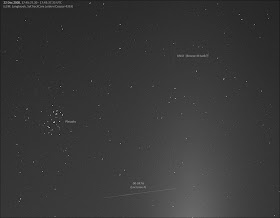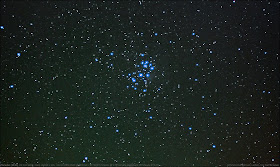I photographed Lacrosse 4 with the Pleiades just before eclipse (see below). When inspecting the image for astrometric reduction, I noted a second, fainter trail on the image. Measuring it and running an ID, I found it was close to predicted positions for the Breeze-M (deb) tank, 05-019C. There was an odd 0.6 degree discrepancy though. Mike solved it by pointing out that a SDP4 solution yielded perfect residues, while the SGP4 theory SatFit uses doesn't. So, the question mark plus the "UNID" in below image can be erased.
(click image to enlarge)

Later that night, after the LEO window closed, I spent some time doing astrophotography with my camera piggyback on my Meade ETX-70. I still have to stack part of the images, but already finished stacking 102 x 10s exposures of the Pleiades with the EF 50/2.5 lens, yielding this result:
(click image to enlarge)

Marco,
ReplyDeleteHet verbaast me dat je geen grotere scope gebruikt voor je waarnemingen. Hele gave blog, maar zou je geen betere resultaten krijgen met groter aparatuur ?
Stephan Abraas
Stargate Observatory
Canon City, Colorado
abraas1389@msn.com
@ Stephan:
ReplyDeleteMet de apparatuur die ik op dit moment voor satellietwaarnemingen gebruik, is de nauwkeurigheid in principe al ruim genoeg. Puur astrometrisch is ze uit te drukken in de orde van boogseconden! De grootste onnauwkeurigheidsfaktor zit hem niet in de astrometrie (en dus het observatie-instrument), maar in de tijdsbepaling. 0.1 seconde onnauwkeurigheid in de tijdsbepaling leidt al tot een onnauwkeurigheid van 2' in de bepaalde positie, dus een onnauwkeurigheid die vele malen groter is dan de fout in de puur astrometrische positiebepaling op de fotografische plaat. De cross-track error, die niet beinvloed wordt door de onnauwkeurigheid in het tijdstip, is vrijwel altijd (en vaak veel) beter dan 30".
Grotere telescopen hebben het nadeel van een kleiner beeldveld (en bovendien heb ik er geen ruimte en geen geld voor).